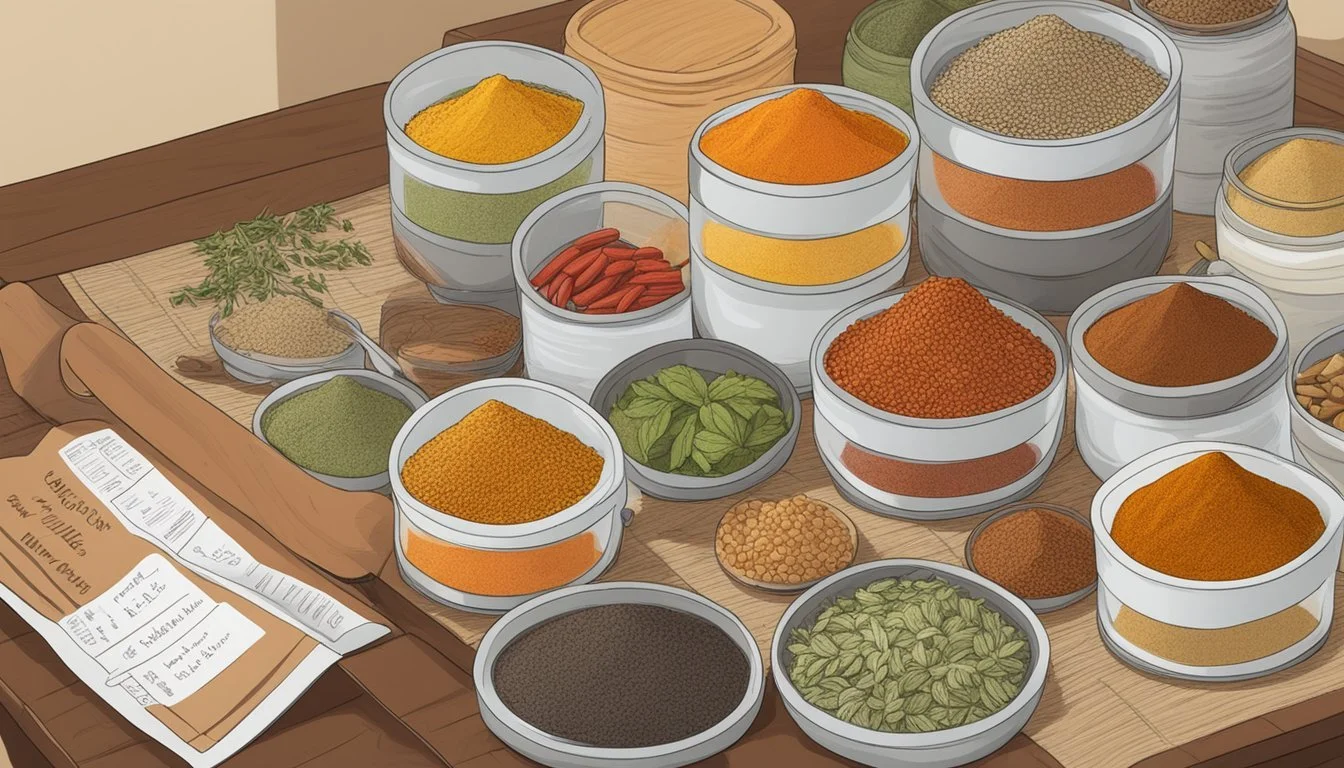Chili Powder Substitutes
Top Alternatives for Your Recipes
For those moments when chili powder is missing from the spice rack, don't worry. There are numerous alternatives that can achieve similar flavor profiles. Taco seasoning is a popular substitute for chili powder and includes many of the same spices such as cumin, oregano, and garlic powder. This can be a convenient option, especially in many Mexican-American dishes.
Another effective blend includes mixing paprika, ground cumin, and a touch of cayenne pepper. For every tablespoon of chili powder, use 2 teaspoons of paprika, 1 teaspoon of cumin, and a quarter teaspoon of cayenne. This combination captures the essence of chili powder, providing a balanced heat.
For those who prefer a milder substitute, making a blend with oregano, garlic powder, and onion powder might be the right choice. Each brings aromatic qualities without overwhelming heat, making it suitable for broader applications. By utilizing these common spices, creating a substitute for chili powder becomes a simple task.
Understanding Chili Powder
Chili powder is a blend of spices that adds flavor and heat to many dishes. The components and common uses of chili powder are essential to grasping its role in various cuisines.
Components of Chili Powder
Chili powder typically consists of a mix of ground chili peppers and additional spices. The primary ingredient is often dried and ground red chili peppers such as anchos, guajillos, or chiles de arbol.
In addition to chili peppers, cumin, paprika, garlic powder, onion powder, and oregano are common. Some versions might also include cayenne pepper for an extra kick.
The combination of these spices creates a complex flavor profile that is both earthy and spicy. This blend is a staple in Mexican and Tex-Mex cooking.
Common Uses in Cuisine
Chili powder is versatile and widely used in various dishes. In Mexican cuisine, it is a key ingredient in tacos, enchiladas, and mole sauces. Its robust flavor enhances the taste of soups, stews, and chili con carne.
In Tex-Mex dishes, chili powder seasons ground beef for tacos, burritos, and nachos. It is also popular in barbecue rubs and spice blends for meats.
Homemade blends allow for customization of spiciness and flavor intensity. Chili powder’s versatility makes it indispensable in creating flavorful dishes.
Criteria for Choosing Substitutes
When selecting chili powder substitutes, it is crucial to consider both the flavor profile and the heat level of the alternative options. This ensures that the substitute effectively complements your dish.
Flavor Profile Considerations
Different chili powders and their substitutes vary greatly in flavor. For instance, paprika has a sweet or smoky undertone, depending on whether it's sweet or smoked paprika. This makes it suitable for dishes requiring a milder flavor.
Ancho powder offers a deep, rich taste with a hint of fruitiness, making it ideal for recipes where the chili powder is a key flavor component. Blends made with cumin, garlic powder, onion powder, and oregano allow customization and can closely mimic the complex flavors found in commercial chili powder mixes. Evaluating the base ingredients in your dish helps in choosing a substitute that won't overpower or clash with existing flavors.
Heat Level Matching
The spiciness or heat level of chili powders varies significantly. Cayenne pepper is quite hot and should be used cautiously. In comparison, ancho powder is milder and provides a gentle heat suited for those sensitive to spiciness.
When using blends such as taco seasoning, note that they often contain moderate heat and other spices like cumin and oregano. Adjusting the quantity can help control the heat. Homemade blends allow you to customize the heat level, adding more or less cayenne pepper or other hot spices as needed. Starting with half the amount when substituting is a practical approach to avoid overpowering heat.
Common Chili Powder Substitutes
When you need to replace chili powder in a recipe, a variety of substitutes can provide the desired heat and flavor. This section breaks down some of the most common alternatives.
Paprika
Paprika is a staple in many kitchens and serves as an excellent alternative to chili powder. This spice is made from ground sweet red peppers and comes in sweet, smoked, and hot varieties.
Flavor: Mild and a bit sweet, which can add depth without overwhelming heat.
Usage: Ideal for stews, soups, and meats where a subtle pepper flavor is desired.
Note: Smoked paprika adds a smoky flavor, making it useful in barbecue and grilling recipes.
Cayenne Pepper
Cayenne pepper is another popular substitute. It is much hotter than typical chili powder, so use it sparingly.
Flavor: Very hot and spicy.
Usage: Suitable for dishes that can handle significant heat, like spicy soups, sauces, and rubs for meats.
Note: Because of its high heat, start with a small amount and adjust to taste.
Red Pepper Flakes
Red pepper flakes are crushed dried peppers and a versatile spice in the kitchen. They add more visual appeal and chunkiness to dishes compared to powdered spices.
Flavor: Hot and mildly fruity.
Usage: Perfect for pizza, pasta, and stir-fries where a burst of heat is needed.
Note: The level of heat can be adjusted by controlling the amount used.
Ancho Powder
Ancho powder is made from dried and ground poblano peppers. It stands out with its rich, slightly sweet, and smoky flavor.
Flavor: Mild heat with a fruity and smoky taste.
Usage: Great for soups, stews, and mole sauces where a deeper, more complex flavor is required.
Note: Works best in combination with other spices like cumin and oregano for a balanced flavor profile.
Specialty Chili Powder Substitutes
For those looking to maintain distinct flavors in their recipes, specialty chili powder substitutes like Chipotle Powder, Guajillo, and Chile de Arbol offer unique culinary experiences. These substitutes each bring their own flavor profiles to the table, making them valuable alternatives.
Chipotle Powder
Chipotle powder, made from smoked and dried jalapeño peppers, introduces a smoky and earthy flavor to dishes. It can add depth to recipes like chili, stews, and rubs for meats.
The smoky flavor is intense, so it's advisable to start with a small amount and adjust according to taste. This powder is excellent for enhancing barbecue sauces or giving a rich flavor to beans. Chipotle powder also pairs well with tomato-based sauces, adding a distinct undertone.
Guajillo
Guajillo chile powder, derived from dried guajillo chilies, is notable for its mild to moderate heat and fruity undertones. It is a staple in Mexican cuisine, used in sauces, marinades, and moles.
The distinct flavor of guajillo includes notes of berries and tea, making it unique. This powder is perfect for adding complexity to soups and stews. It's also commonly included in spice blends for enhancing the overall flavor profile of tacos or enchiladas.
Chile de Arbol
Chile de Arbol powder is made from small, potent de Arbol chilies and is known for its spicy kick. This powder brings a robust heat and nutty flavor to dishes.
It's ideal for those who enjoy bold, spicy dishes. Chile de Arbol is often used in hot sauces and salsas. Because of its vibrant heat, it should be used sparingly at first. This powder is perfect for seasoning meats, adding to stir-fries, or spicing up soups and stews.
Homemade Substitute Blends
Creating your own homemade chili powder blend allows for customization and can perfectly match your taste preferences. Two crucial aspects are selecting the right spices and grinding them in proper proportions to achieve the best flavor and consistency.
Creating a Custom Spice Blend
To make a homemade chili powder, gather a variety of spices. Common ingredients include ground chili peppers, cumin, garlic powder, and oregano.
Ground Chili Peppers: This forms the base of the blend. Options include ancho, cayenne, or chipotle.
Cumin: Adds earthy notes and complexity.
Garlic Powder: Provides a savory undertone.
Oregano: Enhances aromatic qualities.
You can also consider adding onion powder, paprika, and coriander for additional layers of flavor.
Proportions and Grinding
Balancing the spices in your blend is essential. A typical ratio might be:
3 parts ground chili peppers
1 part cumin
1 part garlic powder
1 part oregano
Adjust these proportions based on personal preferences. For example, use less cayenne if you prefer a milder blend.
After mixing, grind the spices to achieve a uniform texture. Use a spice grinder or mortar and pestle. Store the blend in an airtight container to preserve freshness. Ensure you label the container with the date to keep track of its shelf life.
Additional Substitute Ingredients
Utilizing ground cumin and onion or garlic powder can significantly enhance the flavor of dishes as effective substitutes for chili powder. These individual spices bring out distinct tastes and aromas that are key to various recipes.
Ground Cumin
Ground cumin is a prominent spice that adds a warm, earthy flavor to dishes. It's essential in many cuisines, including Mexican, Indian, and Middle Eastern cooking.
Flavor Profile: Cumin has a slightly bitter taste with a hint of sweetness and a robust aroma.
Usage: When substituting for chili powder, start with a smaller amount (e.g., 1 teaspoon of cumin for every tablespoon of chili powder) to avoid overpowering the dish. Adjust according to taste.
Combination: Combining ground cumin with paprika or oregano can create a more complex flavor profile, somewhat akin to that of chili powder.
Onion and Garlic Powder
Onion powder and garlic powder are versatile and accessible spices that enhance the savory notes of various recipes.
Flavor Profile: Onion powder adds a slightly sweet, yet sharp flavor, while garlic powder has a pungent and robust taste.
Usage: Use equal parts of onion and garlic powder to substitute a portion of chili powder. Typically, 1 teaspoon of each for every tablespoon of chili powder.
Combination: Mixing them with other spices like cumin or paprika can balance the flavors and mimic the complexity of chili powder.
These substitutions not only provide similar flavors but also offer flexibility in adjusting the heat and taste profile to suit specific recipes.
Non-Spicy Alternatives
For those looking to avoid the heat while retaining rich flavors, sweet paprika and smoked paprika serve as excellent substitutes for chili powder.
Sweet Paprika
Sweet paprika, made from ground sweet red peppers, adds vibrant color and mild flavor without any spiciness. This makes it ideal for dishes where the emphasis is on color and sweetness rather than heat.
In Hungarian cuisine, it is often used in traditional goulash. Combining sweet paprika with garlic, onion powder, and ground cumin can create a flavorful mix that enhances dishes without overwhelming them with spice.
Smoked Paprika
Smoked paprika brings a unique smokiness to dishes, derived from peppers that are smoke-dried before being ground. This gives it a deep, woody flavor that can add depth to soups, stews, and meats without adding heat.
It's particularly popular in Spanish cuisine, where it’s used in dishes like paella and patatas bravas. When using smoked paprika, begin with smaller quantities; its smoky flavor can be quite potent.
Adapting Recipes for Allergies and Dietary Restrictions
Adapting recipes for dietary needs involves finding suitable replacements that maintain taste and texture. This article provides insights on non-irritant substitutes and salt-free alternatives for chili powder.
Non-Irritant Substitutes
For individuals with chili allergies, it is crucial to find non-irritant substitutes. Paprika, derived from crushed sweet red peppers, provides a mild, sweet flavor without the heat, making it a popular choice.
Another option is sweet bell pepper powder, which can be made by grinding dried bell peppers.
Smoked paprika adds depth of flavor similar to chili powder’s smokiness but without the spiciness. When creating non-irritant substitutes at home, one can blend dried herbs, such as oregano, with a bit of cumin to mimic the earthy taste of chili powder.
Salt-Free Alternatives
Reducing salt intake can be vital for those with dietary restrictions. Ancho chile powder offers a salt-free, sweet and smoky option. Derived from dried poblano peppers, it provides robust flavor without the need for additional salt.
Paprika and smoked paprika are also excellent salt-free substitutes, adding color and taste.
For added complexity, garlic powder and onion powder can enhance the flavor profile in a salt-free manner. Using a mix of spices like cumin, black pepper, and coriander achieves a well-rounded seasoning without relying on salt.
Combine these spices to suit individual preferences while adhering to dietary guidelines.
Cultural Substitute Variations
Various cuisines have tailored their own versions of chili powder substitutes, each infused with regional flavors and ingredients. This section explores substitutes in both Latin American and Indian dishes.
Latin American Dishes
Latin American cuisine often employs ancho chiles, guajillo chiles, and chiles de arbol as primary chili powder components. Combining these chiles with paprika, ground cumin, garlic powder, onion powder, and a bit of cayenne pepper creates a balanced mix.
In Mexican cuisine, the emphasis is on a blend that can introduce a smoky, sweet, and mildly spicy flavor. Smoked paprika adds depth, while ancho chiles provide a rich, sweet heat. To achieve the right consistency, these ingredients are ground after toasting, releasing their natural oils and intensifying their aroma.
Indian Spice Mixes
Indian spice mixes offer a robust and spicy alternative. Red chili powder is a staple, often substituted with cayenne powder due to their similar heat levels. Each mix aims to balance intense heat with flavor.
Common additions include ground turmeric, coriander powder, and garam masala. These spices not only contribute to the overall heat but also bring in a complexity that defines Indian cuisines. Fenugreek and asafoetida may also be added for a unique pungency and depth.
Blending these ingredients results in a powerful substitute that works well in a variety of dishes, from curries to marinades.
Usage Tips for Chili Powder Substitutes
Using chili powder substitutes effectively depends on the type of dish you're preparing. Different substitutes bring out unique flavors in meats, soups, stews, and dips, enhancing the culinary experience.
Meats and Marinades
When substituting chili powder for meats and marinades, taco seasoning and paprika are excellent choices. Taco seasoning offers a balanced blend of spices, including chili powder, cumin, oregano, and garlic powder. It works well with ground beef for burritos or enchiladas.
For marinades, using a combination of paprika, cumin, garlic powder, and a hint of cayenne pepper can create a robust flavor profile. This mix enhances the taste of grilled meats like chicken or steak, adding depth without overpowering the natural flavors of the meat. Keep in mind to adjust the spiciness to match personal preference by controlling the amount of cayenne pepper.
Soups and Stews
For soups and stews, New Mexico chili powder comes highly recommended. This powder, made from New Mexico chili peppers, brings an earthy and robust flavor that complements dishes such as chili con carne and beef stew.
Smoked paprika can be another great substitute, providing a smoky undertone to soups and stews, enriching the base flavor. Crushed red pepper flakes can be used sparingly if a recipe calls for a bit of heat. Incorporate these substitutes gradually, tasting often, to avoid overpowering the dish. To achieve a well-rounded taste, consider blending with cumin, dried oregano, and garlic powder.
Sauces and Dips
For sauces and dips, such as salsa or Tex-Mex queso, pure ancho chili powder makes an excellent substitute. Ancho chili powder brings a mild heat and a fruity essence, which melds well with tomatoes and cheese.
Taco seasoning is versatile for various Tex-Mex dishes, providing a rich and spicy flavor. Guajillo chili powder can also be used to add a slightly sweet and tangy note to enchilada sauces and diverse dips. When mixing these substitutes, balance is key—use measured amounts to maintain the intended flavor profile without overwhelming the sauce or dip.
Storage and Shelf Life of Chili Substitutes
Proper storage significantly impacts the shelf life and flavor of chili powder substitutes. Keep spice blends fresh by following the best practices for storing and maximizing freshness.
Storing Spices
Proper storage is essential to extend the shelf life of spice blends. Store chili powder substitutes in airtight containers. Ideally, these containers should be glass, as it protects against light and moisture better than plastic.
Keep the containers in a cool, dark place like a pantry. Avoid areas near heat sources like stoves or sunlight-exposed shelves. Heat and light degrade the potency of spices.
Ensure the storage place stays dry. Humidity can cause clumping and spoilage. Label containers with the date of purchase to monitor freshness.
Maximizing Freshness
To maintain the optimal flavor of chili powder substitutes, consider the following tips. Grinding whole spices just before use significantly boosts freshness and flavor.
Avoid mixing old and new batches. This prevents contamination and helps track the age of spices accurately. If a blend includes garlic or onion powder, know that these have shorter lifespans and can affect the entire mix.
Smell the spices periodically. A lack of aroma indicates reduced potency. Spices should generally be replaced every 1-3 years, depending on their type and storage conditions.
For long-term storage, consider vacuum sealing or refrigeration. This is particularly useful for infrequently used spices.







